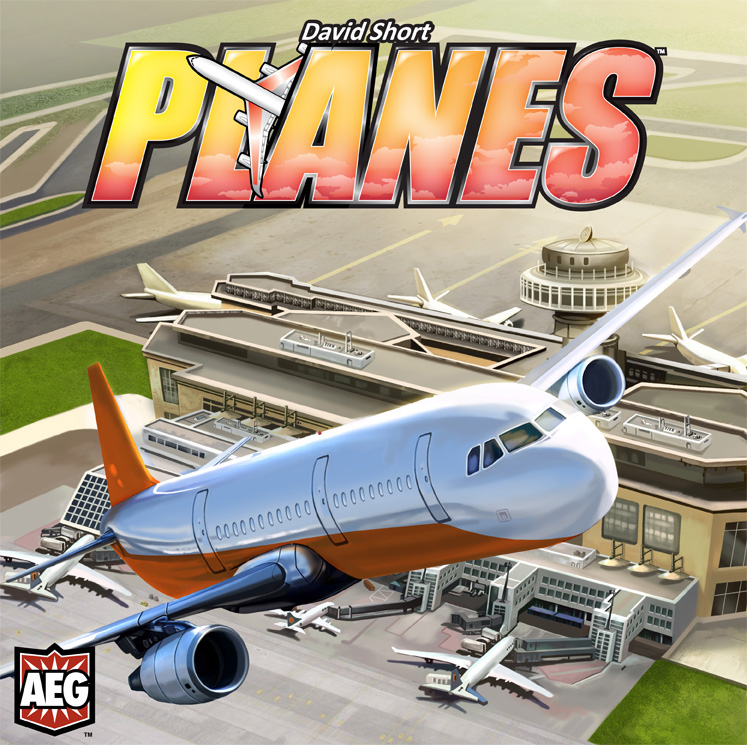“Planes” is essentially “Mancala” with cards in an airport…I’ll let you wrap your head around that for a minute. Players are tasked with moving the cubes of their color to the matching plane. Cards exist to not only allow you to take special actions, but to give you a way to score extra victory points. Are YOU crafty and agile enough to get your party to the right terminal, or will you miss your flight? Either way, you’ll be pleased to know that you won’t have to be frisked at security nor will you have to deal with baggage claim hell.
Components
The game includes 1 Double-sided airport board, 60 Playing cards, 4 Player aids, 20 Party cubes (5 ea. of red, blue, green, yellow), 20 Neutral cubes, 4 Plane tokens (1 ea. of red, blue, green, yellow), 44 Point of interest tokens (14 of the tokens are blanks), 6 Blockage cones, and 1 Boarding token.
Setup & Gameplay
There’s an entire page devoted to game setup in the manual, so I’ll simply offer the highlights. Players choose a starting player, then a color. Player 1 put the cubes of their color on the P1 space and in clockwise order, players follow suit utilizing the P2, P3, and P4 spaces (all color cubes will still be used, even in a two/three player game, to fill out the empty P spaces). Two neutral cubes are placed on all other empty spaces. Plane tokens are placed at the appropriate gates (P1 = G1, P2 = G2, etc.) and any color cubes not assigned to a player has their plane flipped to the “draw 2 cards” side up. Each player gets three cards from the shuffled draw deck to form their starting hand. Players may customize points of interest if they so wish.
The game is played over several rounds until all of the planes of a color are full or 12 or more cubes have board onto planes. A player’s turn consists of the following:
1. Action Phase (optional): Play one action by playing a card from your hand.
2. Move Phase (mandatory): Move one member of their party from one space to another. All cubes (regardless of color) are picked up and dropped one at a time onto the subsequent spaces (one cube per one space, like in “Mancala”). If the last cube in the player’s hand lands at a gate matching their color, they may board it. When this happens, the token on the boarding track is moved upward. When seven or more cubes occupy a single space, a blockage cone is placed there preventing anyone from advancing past it.
3. Goal Phase (optional): Play one card as a goal. The card remains face up for endgame scoring.
If the player has no cards in their hand at the end of their turn, they may draw one. When the endgame conditions are met and each player has had an equal number of turns, players add up their victory points (from boarding and goals) and whoever has the most, wins!
Editor’s Note: The above doesn’t cover all of the rules found in the manual, but should give you an idea as to how the game is played.
The Review
I found “Planes” to be pretty interesting, but it didn’t wow me in any particular way. Anyone who has played “Mancala” will easily see the correlation between the two games, though this one has cards that can be used as either actions or goals (the latter of which nets you more victory points). I liked this dual role that the cards played as I often felt torn between using an action to help my cubes board their plane and saving it to try and satisfy the listed goal. There were a few times using an action could have netted me a successful boarding attempt, though it’s perfectly viable to sit on them and hope your opponent changes the board in your favor with their move (allowing you to board the plane without spending your card as an action).
The fact that you can use the points of interest tokens to change where they initially reside is a nice touch. If you don’t want them all to sit at the far ends of the board for example, then you can use blank tokens to cover some of those spaces up and put their matching tokens somewhere else. The manual recommends that for the sake of fairness that players keep things equal on both sides of the board, meaning if you place a help desk at G1 then you should also place one at G2, G3, and G4. There’s also a suggested hierarchy of availability listed (restrooms and fast food should be easier to find than help desks and restaurants, for example), though you’re free to mix things up at your leisure and unbalance the game however you’d like.
In addition to being able to switch up the points of interest, you can separate the cards by player dot colors so that each player has the exact same 15 cards to use in a personal draw deck (as opposed to the standard public one which includes all cards). You can also shorten the game by playing to “8” instead of “12” on the boarding track…though you can choose any number you want. All of these customizable features gives “Planes” a lot of replayability and flexibility, which should hopefully keep you coming back for more (assuming you enjoy actually playing the game). At $20 (the price on Amazon as of 10/19/15), I recommend giving this one a go.
Final Verdict: 6/10
—


